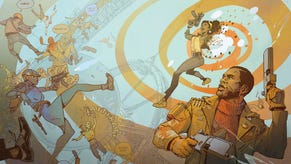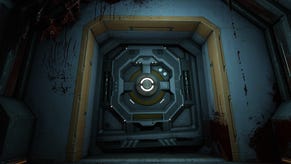When is a layer not a layer? Dishonored 2's intricate approach to level design
Plus 20 minutes of gameplay.
Last week, Aoife and I paid a visit to Bethesda's offices in London to get hands on with Dishonored 2; we had a couple of hours to fully explore the clockwork mansion level as we learned how to use Emily's powers and got reacquainted with Corvo now he's learned to talk.
The clockwork level itself is quite impressive. It also seems like a real statement, emphasising that the opulent, Victorian inspired visuals that so characterise Dishonored are more than just set dressing; as you go about the house, you pull levers to reconfigure the environment around you with a satisfying series of clicks, clanks and whirs. Reconfiguring the house, of course, opens up different pathways to your target - in this instance, the renowned inventor Kirin Jindosh. It's a strong reminder that while Dishonored 2 (and the original Dishonored) may not be a puzzle game, it's sure as hell built like one.
I spoke to lead level designer Christophe Carrier at EGX to explore the design ethos behind Dishonored 2 and, indeed, the clockwork mansion. Before we dive into that though, you might want to watch the video first in order to get a good sense for what the level actually is.
As you may have gleaned from our wildly differing approaches to the same level, Dishonored 2 is all about supporting player choice. Players can confront everything head on or sneak around the sides, and then there's also the question of powers to consider; Dishonored 2 allows you to refuse the Outsider's offer of occult magic powers for the first time, allowing you to play the entire game as an ordinary, squishy human.
I asked Christophe how one goes about designing a level with those different approaches in mind - does he start with those people who aren't going to use any powers at all and then layer it up for the people who will? How does one go about building something like that? "Well that's the challenge of course," he began, shifting in one of the NEC's most comfortable plastic chairs, "but to answer your question we don't work with layers. When we make the level, we build the basics first; the main buildings, the balconies and the apartments and then on top of that - well it's kind of a layer [laughs]. While I'm talking I'm realising that it's a layer but we are digging deeper into it and we add or remove things. Entrances, new paths, and of course we had to deal with the no power players to that they have an experience that is as fun as all the other people.
"I try to play the game in no power [mode] as much as possible to give the player the same fun as if they were using the powers. And it's more difficult of course, but it's as fun I think. For example, somewhere where you could go by blinking or far reaching, you have to find the way to go up or down and it's more hidden - you have to search your environment and I think for a no power player, it's fun to have to find solutions like that. it's not a puzzle per se, but the pleasure comes from 'Yeah, I found it! That's where I have to go with no powers.'"
Whether using powers or not, the clockwork mansion is certainly an environment that rewards exploration. I played through the mission three times and - as I discovered in conversation after the session - still managed to miss a whole chunk of stuff hidden away. While it inevitably means that players often miss entire swathes of the level, Christophe explained that this is very much part and parcel of the Dishonored experience.
"You know, the thing that is really awesome for us is to see players talking to other players saying 'what did you do? I went there but had to do this - no! You could do this and you know, take this window' and they go 'oh I'll try this next time' and that stuff we call the coffee machine talks... in my work, when I hear that, I'm so happy to hear that from players; that they're not playing the same game. That's one of the things I love about working on Dishonored - that you can see everyone is doing something different, but they have equal fun.
"You know at Valve they have an entirely different perspective. They say - as far as I remember, it was a long time ago - they say everything we do should be seen by the player. Right? And I totally respect that because you put a lot of work into a game so you want to show everything you've done. For us, we have to accept that some players will never see an entire part of the level - so that's different. But, at the end of the day, it encourages replayability - because when a player hears from other players that they didn't see the same thing, they have the feeling that they probably missed something - or maybe that it was an entirely new way to do a level and it's like playing an entirely new game, I'm not sure, but this kind of thing is really fun."










